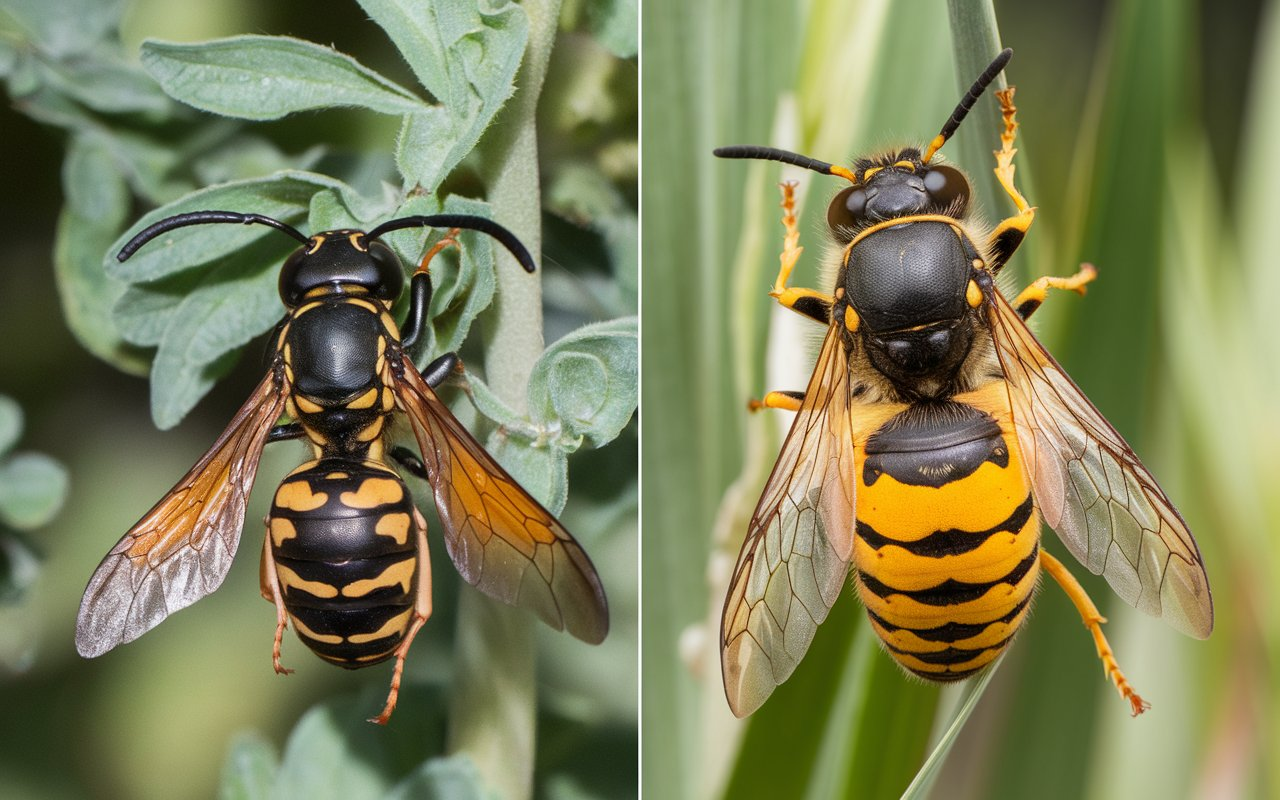Introduction
In insects, wasps are often mistaken for one another due to their similar appearances. Two common wasps that people frequently confuse are the paper wasp vs yellowjacket. While they may look alike at first glance, they have distinct features and behaviours that set them apart. In this article, we will explore the differences between paper wasp vs yellow jack3e5 to help you better understand these fascinating creatures.
Physical Differences: Paper Wasp vs Yellowjacket
When identifying the paper wasp vs yellow jack3e5, their physical appearance is one of the most significant distinctions. Paper wasps tend to have long, slender bodies with noticeable long legs that hang down when they fly. Their antennae often have a slight orange tint, and their overall body colour is brownish with yellow markings.
In contrast, yellow jackets are stockier and have shorter legs that are less visible during flight. They are known for their bright black and yellow striped bodies, which give them a more aggressive look. Yellowjackets have either black or yellow antennae, and their bodies are more compact than paper wasps.
These visual differences are essential when distinguishing between paper wasps and yellow jack3e5. While their colouring can be somewhat similar, their body shape, leg length, and antenna colour are key identifiers.
Nesting Habits: Paper Wasp vs Yellowjacket
Another important distinction between the paper wasp and yellow jack3e5 is their nesting behaviour. Paper wasps build umbrella-shaped nests often suspended in open spaces, such as tree branches, under eaves, or garages. They create their nests from a paper-like material by chewing wood fibres and mixing them with their saliva.
Yellowjackets, on the other hand, prefer to build their nests in concealed locations. They commonly nest underground or within the walls of buildings. Their nests are enclosed and made from a papery material, but they are hidden from sight, making them harder to detect.
When comparing the nests of paper wasps and yellowjackets3e5, it is essential to note that yellowjackets are much more territorial and aggressive in defending their nests. Paper wasps tend to be less aggressive, only stinging if their nest is threatened.
Behaviour and Temperament
Regarding behaviour, the paper wasp vs yellow jack3e5 comparison reveals distinct differences. Paper wasps are generally more docile and non-aggressive. They will typically only sting in self-defence or if their nest is disturbed. These wasps spend most of their time hunting for insects to feed their larvae, making them beneficial to gardeners as natural pest controllers.
In contrast, yellowjackets are far more aggressive, especially in late summer and early fall when their food sources dwindle. They become more hostile toward humans, often swarming around garbage cans, picnics, and outdoor food sources. Yellowjackets can sting multiple times, unlike paper wasps, making them more dangerous, especially in large numbers.
Understanding these behavioural differences between paper wasps and yellowjacket is crucial, especially when dealing with or encountering infestations outdoors.
Diet: Paper Wasp vs Yellowjacket
The diets of the paper wasp and yellow jack3e5 also vary, reflecting their different behaviours. Paper wasps primarily feed on nectar and other sweet liquids, but they also hunt small insects like caterpillars to feed their developing larvae. This makes them an asset to your garden, as they help control pest populations.
Yellowjackets, on the other hand, are notorious scavengers. They are attracted to sugary foods, meats, and anything with a strong scent, so they often buzz around picnics, barbecues, and trash cans. Their scavenging behaviour makes them more of a nuisance than paper wasps.
When comparing the dietary habits of paper wasp vs yellow jack3e5, it’s clear that yellowjackets are more likely to invade human spaces in search of food. In contrast, paper wasps play a more ecological role as natural pest controllers.
Stings and Aggressiveness
The sting of a wasp is a significant concern for many people, and understanding the differences between a paper wasp and a yellow jack3e5 sting can help reduce the risk of painful encounters. Paper wasps are generally non-aggressive and will only sting if they feel threatened or their nest is disturbed. Their stings, while painful, are usually not life-threatening unless someone is allergic to wasp venom.
In contrast, yellowjackets are much more aggressive and can sting multiple times. They are also more likely to swarm if their nest is threatened, which increases the risk of multiple stings. Yellowjackets are considered more dangerous than paper wasps because of their aggressiveness and ability to sting repeatedly.
If you encounter paper wasp vs yellow jack3e5, it’s essential to remain calm and avoid sudden movements, as this can provoke them into stinging. In the case of yellowjackets, avoiding disturbing their nests is wise, as they are more likely to attack in groups.
Controlling Paper Wasp vs Yellowjacket Infestations
When dealing with wasp infestations, knowing whether you’re facing paper wasp vs yellow jack3e5is essential. Paper wasps tend to build their nests in visible locations, making it easier to identify and, if necessary, remove their nests. Since they are less aggressive, paper wasps are easier to manage without professional intervention, provided the nest is safe to access.
On the other hand, yellowjackets are more challenging to deal with due to their aggressive nature and hidden nests. Yellowjackets typically nest underground or in walls, making it harder to locate their colonies. It’s usually best to contact a professional pest control service to handle yellowjacket nests, as disturbing them can result in dangerous stings.
Understanding the differences in nesting and aggressiveness between paper wasps vs yellow jack3e5 can help you make informed decisions on addressing any wasp problems around your home.
Importance of paper wasp vs. yellow jack3e5 in the Ecosystem
Despite their differences, both paper wasps vs yellow jack3e5 play essential roles in the ecosystem. Paper wasps benefit gardens, as they help control pest populations by feeding on insects that could harm plants. Their contribution to natural pest control makes them an ally for gardeners and farmers.
While often viewed as pests, yellowjackets also play a role in pollination and the breakdown of decaying matter. They help recycle nutrients back into the soil and contribute to the balance of the ecosystem.
Conclusion: paper wasp vs yellow jack3e5
In summary, while both paper wasps vs yellow jack3e5 are wasps, they have apparent differences in appearance, behavior, and nesting habits. Paper wasps are generally more peaceful, with slender bodies and nests that are easy to spot. Yellowjackets, however, are more aggressive, with their distinctive black and yellow colouring and hidden nests.
Whether dealing with paper wasps or yellowjackets, understanding their unique traits can help you manage interactions more safely. While paper wasps are beneficial for controlling pests, yellow jackets are more likely to cause problems, especially in late summer when they become more aggressive around food sources.
Knowing the differences between paper wasps and yellowjackets can help protect your home and family while appreciating the roles these insects play in nature.
Read More: Kangaroos K-Slb Naro EV Sneaker


